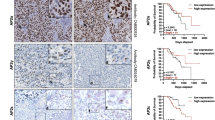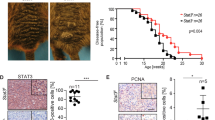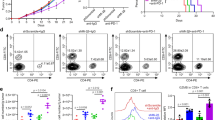Abstract
The secreted MIA protein is strongly expressed by advanced primary and metastatic melanomas but not in normal melanocytes. Previous studies have shown that MIA serum levels correlate with clinical tumour progression in melanoma patients. To provide direct evidence that MIA plays a role in metastasis of malignant melanomas, A-mel 3 hamster melanoma cells were transfected with sense- and antisense rhMIA cDNA and analysed subsequently for changes in their tumorigenic and metastatic potential. Enforced expression of MIA in A-mel 3 cells significantly increased their metastatic potential without affecting primary tumour growth, cell proliferation or apoptosis rate in hamsters, compared with control or antisense transfected cells. Additionally, MIA overexpressing transfectants showed a higher rate of both tumour cell invasion and extravasation. Cells transfected with MIA antisense generally exerted an opposite response. The above changes in function attributed to the expression of MIA may underlie the contribution of MIA to the malignant phenotype. © 2000 Cancer Research Campaign
Similar content being viewed by others
Article PDF
Change history
16 November 2011
This paper was modified 12 months after initial publication to switch to Creative Commons licence terms, as noted at publication
References
Apfel R, Lottspeich F, Hoppe J, Behl C, Durr G and Bogdahn U (1992) Purification and analysis of growth regulating proteins secreted by a human melanoma cell line. Melanoma Res 2: 327–336
Blesch A, Bosserhoff AK, Apfel R, Behl C, Hessdoerfer B, Schmitt A, Jachimczak P, Lottspeich F, Buettner R and Bogdahn U (1994) Cloning of a novel malignant melanoma-derived growth-regulatory protein, MIA. Cancer Res 54: 5695–5701
Bogdahn U, Apfel R, Hahn M, Gerlach M, Behl C, Hoppe J and Martin R (1989) Autocrine tumor cell growth-inhibiting activities from human malignant melanoma. Cancer Res 49: 5358–5363
Bosserhoff AK, Kaufmann M, Kaluza B, Bartke I, Zirngibl H, Hein R, Stolz W and Buettner R (1997a) Melanoma-inhibiting activity, a novel serum marker for progression of malignant melanoma. Cancer Res 57: 3149–3153
Bosserhoff AK, Kondo S, Moser M, Dietz UH, Copeland NG, Gilbert DJ, Jenkins NA, Buettner R and Sandell LJ (1997b) Mouse CD-RAP/MIA gene: structure, chromosomal localization, and expression in cartilage and chondrosarcoma. Dev Dyn 208: 516–525
Bosserhoff AK, Golob M, Buettner R, Landthaler M and Hein R (1998) [MIA (“melanoma inhibitory activity”). Biological functions and clinical relevance in malignant melanoma]. Hautarzt 49: 762–769
Buettner R, Yim SO, Hong YS, Boncinelli E and Tainsky MA (1991) Alteration of homeobox gene expression by N-ras transformation of PA-1 human teratocarcinoma cells. Mol Cell Biol 11: 3573–3583
Dellian M, Richert C, Gamarra F and Goetz AE (1996) Photodynamic eradication of amelanotic melanoma of the hamster with fast acting photosensitizers. Int J Cancer 65: 246–248
Fidler IJ (1990) Critical factors in the biology of human cancer metastasis: twenty-eighth G.H.A. Clowes memorial award lecture. Cancer Res 50: 6130–6138
Fidler IJ (1996) Critical determinants of melanoma metastasis. J Investig Dermatol Symp Proc 1: 203–208
Hangan D, Morris VL, Boeters L, von Ballestrem C, Uniyal S and Chan BM (1997) An epitope on VLA-6 (alpha6beta1) integrin involved in migration but not adhesion is required for extravasation of murine melanoma B16F1 cells in liver. Cancer Res 57: 3812–3817
Jacob K, Bosserhoff AK, Wach F, Knuchel R, Klein EC, Hein R and Buettner R (1995) Characterization of selected strongly and weakly invasive sublines of a primary human melanoma cell line and isolation of subtractive cDNA clones. Int J Cancer 60: 668–675
Killion JJ, Radinsky R and Fidler IJ (1998) Orthotopic models are necessary to predict therapy of transplantable tumors in mice. Cancer Metastasis Rev 17: 279–284
Koehler MR, Bosserhoff A, von Beust G, Bauer A, Blesch A, Buettner R, Schlegel J, Bogdahn U and Schmid M (1996) Assignment of the human melanoma inhibitory activity gene (MIA) to 19q13.32-q13.33 by fluorescence in situ hybridization (FISH). Genomics 35: 265–267
Koop S, MacDonald IC, Luzzi K, Schmidt EE, Morris VL, Grattan M, Khokha R, Chambers AF and Groom AC (1995) Fate of melanoma cells entering the microcirculation: over 80% survive and extravasate. Cancer Res 55: 2520–2523
Kopf AW, Salopek TG, Slade J, Marghoob AA and Bart RS (1995) Techniques of cutaneous examination for the detection of skin cancer. Cancer 75: 684–690
Ledda MF, Adris S, Bravo AI, Kairiyama C, Bover L, Chernajovsky Y, Mordoh J and Podhajcer OL (1997) Suppression of SPARC expression by antisense RNA abrogates the tumorigenicity of human melanoma cells. Nat Med 3: 171–176
Morris VL, MacDonald IC, Koop S, Schmidt EE, Chambers AF and Groom AC (1993) Early interactions of cancer cells with the microvasculature in mouse liver and muscle during hematogenous metastasis: videomicroscopic analysis [see comments]. Clin Exp Metastasis 11: 377–390
Sage EH and Bornstein P (1991) Extracellular proteins that modulate cell-matrix interactions. SPARC, tenascin, and thrombospondin. J Biol Chem 266: 14831–14834
Schreiner C, Fisher M, Hussein S and Juliano RL (1991) Increased tumorigenicity of fibronectin receptor deficient Chinese hamster ovary cell variants. Cancer Res 51: 1738–1740
Stallmach A, von Lampe B, Matthes H, Bornhoft G and Riecken EO (1992) Diminished expression of integrin adhesion molecules on human colonic epithelial cells during the benign to malign tumour transformation. Gut 33: 342–346
Stetler Stevenson WG, Aznavoorian S and Liotta LA (1993) Tumor cell interactions with the extracellular matrix during invasion and metastasis. Annu Rev Cell Biol 9: 541–573
Weilbach FX, Bogdahn U, Poot M, Apfel R, Behl C, Drenkard D, Martin R and Hoehn H (1990) Melanoma-inhibiting activity inhibits cell proliferation by prolongation of the S-phase and arrest of cells in the G2 compartment. Cancer Res 50: 6981–6986
Author information
Authors and Affiliations
Rights and permissions
From twelve months after its original publication, this work is licensed under the Creative Commons Attribution-NonCommercial-Share Alike 3.0 Unported License. To view a copy of this license, visit http://creativecommons.org/licenses/by-nc-sa/3.0/
About this article
Cite this article
Guba, M., Bosserhoff, AK., Steinbauer, M. et al. Overexpression of melanoma inhibitory activity (MIA) enhances extravasation and metastasis of A-mel 3 melanoma cells in vivo. Br J Cancer 83, 1216–1222 (2000). https://doi.org/10.1054/bjoc.2000.1424
Received:
Revised:
Accepted:
Published:
Issue date:
DOI: https://doi.org/10.1054/bjoc.2000.1424
Keywords
This article is cited by
-
Emerging Biomarkers in Cutaneous Melanoma
Molecular Diagnosis & Therapy (2018)
-
Zbtb7a suppresses prostate cancer through repression of a Sox9-dependent pathway for cellular senescence bypass and tumor invasion
Nature Genetics (2013)
-
The PHSCN dendrimer as a more potent inhibitor of human breast cancer cell invasion, extravasation, and lung colony formation
Breast Cancer Research and Treatment (2011)
-
Increased potency of the PHSCN dendrimer as an inhibitor of human prostate cancer cell invasion, extravasation, and lung colony formation
Clinical & Experimental Metastasis (2010)
-
miRNA Expression Profiling in Melanocytes and Melanoma Cell Lines Reveals miRNAs Associated with Formation and Progression of Malignant Melanoma
Journal of Investigative Dermatology (2009)



